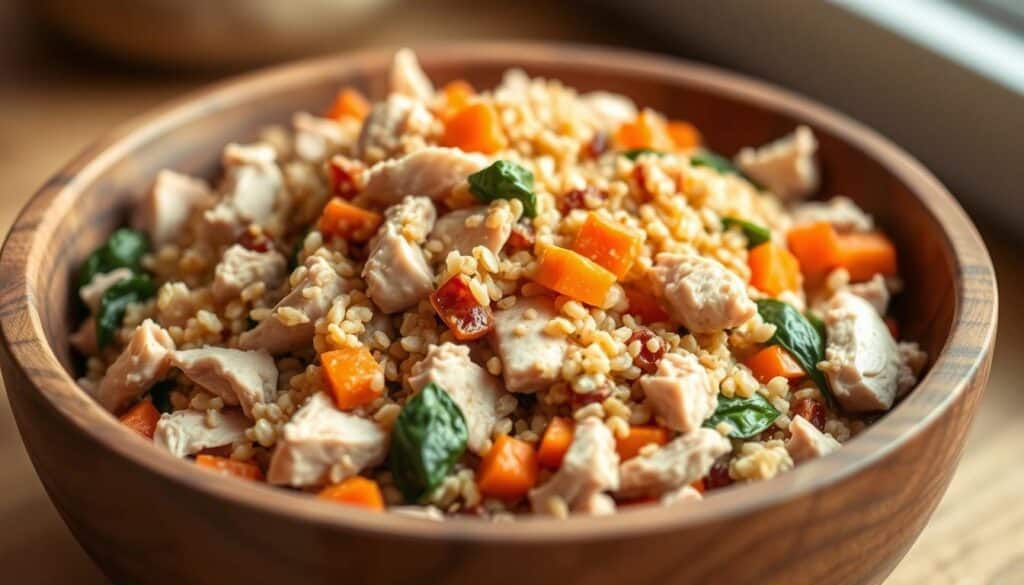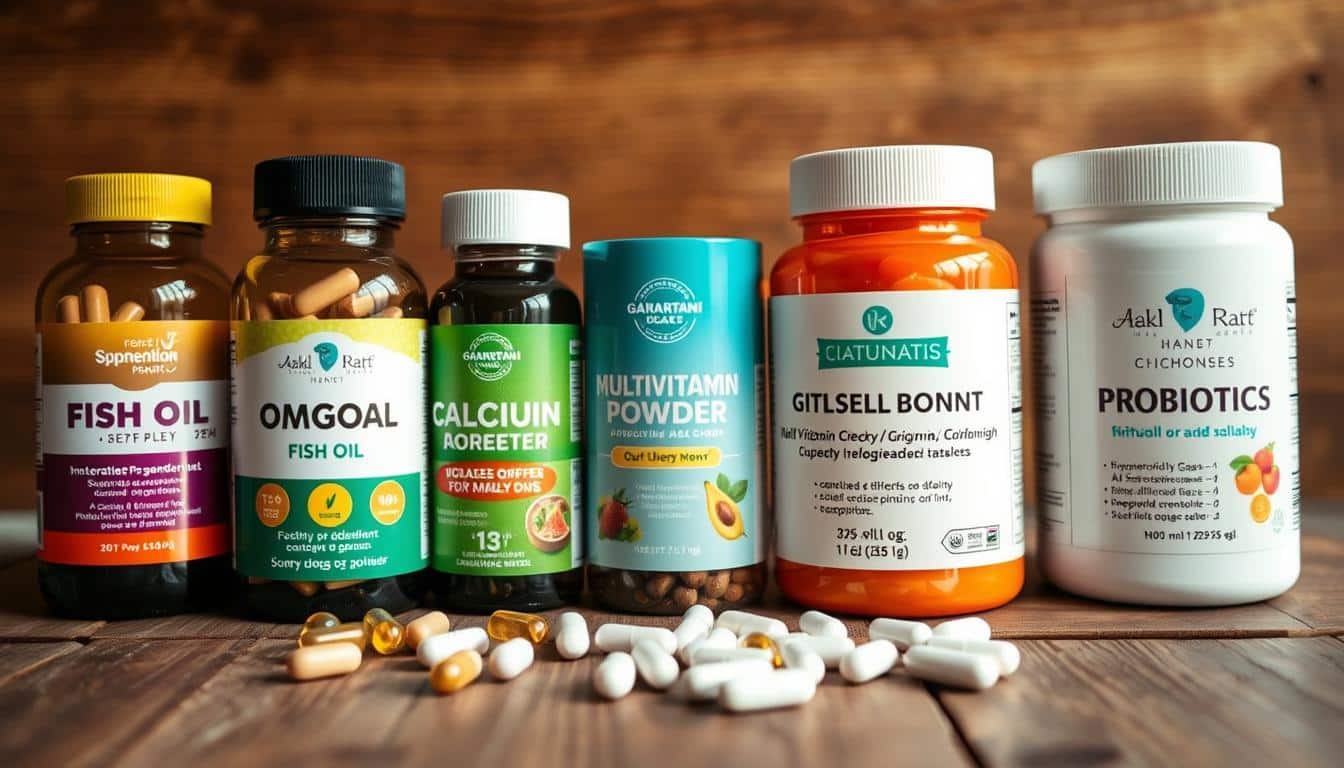Making meals for small dogs with allergies requires a clear plan. The goals are to lessen allergy symptoms, help their skin and gut, and control ingredients. When owners make their own dog food, they often notice their dogs itch less. They also see fewer infections and hot spots. This happens when the food has lean proteins and oils full of omega-3.
Feeding small dogs is different from feeding big dogs. A good diet for them includes proteins, easy-to-digest starches, veggies, and extra calcium. Aiming for half of their diet to be protein and the rest veggies and starches keeps them energetic. It also keeps their fur looking good.
To start, use simple, allergy-friendly ingredients like turkey, venison, or fish. Sweet potatoes or quinoa are good for carbs. Always check with your vet first, especially when trying new foods. Switch foods slowly over a week or so. This helps avoid stomach issues and find out what causes allergies.
Why specialized meal prep matters for toy dogs with allergies
Small breeds need meals that are right for their size and allergies. Custom meal plans help control allergies and match their small appetites. Standard dog food may not have enough nutrients for toy breeds. This could make owners feed too much, raising the risk of weight gain and skin problems.
Unique nutritional needs of toy breeds
Toy dogs need more nutrients in less food. They need meals full of high-quality protein, fats, and essential micronutrients. Omega-3 and antioxidants are key for their skin health and to lessen inflammation.
How allergies present differently in small breeds
Allergy signs in toy dogs can be strong. You might see them licking their paws a lot, getting ear infections, or shaking their heads often. These signs can come quicker than in big dogs. People might think it’s something in the air, but it’s often the food they eat.
Risks of inadequate or imbalanced homemade diets
Making food at home can miss important nutrients if not done right. Without a premix or vet’s help, your dog could lack calcium, minerals, and taurine. Limited-ingredient diets can help find allergy causes but may not be complete for long-term feeding. Always talk to a vet to make sure homemade meals are full of what your dog needs.
- Adjust food amounts for toy dogs and start with 2% of their body weight each day.
- Focus on rich nutrients by choosing lean proteins and necessary supplements.
- Carefully plan elimination diets to pinpoint allergies and not get mixed up with environmental factors.
Understanding common allergy triggers and symptoms in toy dogs
Toy dogs can show small signs when they react to their food or surroundings. You might notice them scratching a lot, getting ear infections often, or having diarrhea. It’s important to see what patterns emerge to figure out if the issue is food or something else.
Chicken, beef, dairy, wheat, soy, and corn are often to blame. They’re found in many pet foods and snacks. Trying a diet with new proteins may show if the regular food is causing problems.
- Common food culprits: chicken, beef, dairy, wheat, soy, corn.
- Testing tip: blood tests for food allergy are often unreliable; controlled food trials work best.
Typical food allergens for dogs (chicken, beef, dairy, wheat, soy, corn)
Small dogs usually have skin and stomach reactions to food. Look for itching, hair loss, and ear infections often. Dairy and wheat might upset their stomach, while meats like chicken and beef can affect their skin.
Non-food triggers that mimic food allergy symptoms (fleas, dust, pollen)
Things that aren’t food can also cause red, itchy skin. Flea allergies can make a small spot super irritated. Dust and pollen can make dogs scratch a lot and have trouble breathing.
- Flea allergy dermatitis is a top non-food cause of itching in small dogs.
- House dust and seasonal pollen often compound skin and ear problems.
Common signs to watch for: itching, ear infections, licking, hair loss, GI upset
Watch for behaviors like licking paws, rubbing the face, or scooting. Frequent ear infections or ears that look red and smell bad are warning signs. Vomiting or diarrhea are clues to food issues.
- Itching and red, inflamed skin.
- Chronic ear infections and head shaking.
- Excessive licking, hair loss, and hot spots.
- GI upset: diarrhea, vomiting, poor stool quality.
Paying close attention and taking steps—like looking for flea allergies, cutting down on allergy triggers, and testing new diets—can help figure out if the issue is with food or the environment. Write down what you notice and when to help your vet give the best advice. This way, you can keep your toy dog feeling good and their coat shiny.
Key nutrients to include in meals for allergic toy dogs
For a toy dog with allergies, your food choices are important. Pick ingredients that help their skin, digestion, and overall health. Use lean proteins that are new to them, healthy fats, carbs that are easy to digest, and reliable vitamins and minerals.
To avoid allergies, use proteins that only come from one source. Try turkey, venison, duck, or whitefish. These proteins are less likely to cause reactions. They make it easier to see if there are any improvements in your dog’s itching or stomach issues. It’s important to switch between them carefully and keep the meals simple.
Essential fatty acids for skin and coat
Omega-3s from the sea are great for dogs with itchy or inflamed skin. Fish or algae oil give dogs EPA and DHA, which they need more than plant-based ALA. Adding omega-3s can reduce skin redness and make their coats shinier within weeks.
Digestible carbohydrates and soluble fiber
Choose soft starches like sweet potato, pumpkin, and quinoa. They give energy without upsetting their stomach. The right fiber helps dogs have firm stools and a healthy gut. Pumpkin is also a simple way to add moisture and fiber.
Vitamins, minerals, calcium, and taurine
Homemade dog food needs a plan for vitamins and minerals. Using a dog premix can add important nutrients that regular food doesn’t have. They include calcium, minerals, and vitamins. Some mixes also meet the need for taurine, important for some dog breeds’ heart health.
When making a meal, use about half protein, a quarter carbs, and a quarter veggies. Add some fat and a measured premix. If you’re planning to feed homemade meals for a while, talk to your vet or a dog nutrition expert.
Balanced meal prep for toy dogs with allergies
Making meals for small dogs with allergies needs careful planning. Choose lean proteins, easy-to-digest starches, and low-residue veggies. Also, include healthy fats and supplements. This keeps their skin and gut healthy and meets their caloric needs.
Designing a balanced plate: protein, starch, vegetables, fat, and supplements
Fill half the plate with lean proteins like turkey or whitefish. One quarter should be cooked starches such as quinoa or rice. The last quarter is for veggies like steamed carrots or pumpkin. A small spoon of fish or algae oil adds EPA/DHA. A premix supplement provides calcium, vitamins, minerals, and taurine.
Portion and caloric guidelines for toy breeds
For toy dogs, start with feeding 2% of their body weight daily. This is roughly 1/2 cup for every 10 pounds. Adjust this amount based on their activity and condition. Keeping an eye on their weight and energy helps. It’s better to adjust food quantities to their needs instead of following generic instructions.
Maintaining proper omega-6:omega-3 ratio to reduce inflammation
Many dog diets have high omega-6 to omega-3 ratios, often above 10:1. For dogs with allergies, aim for a ratio closer to 5:1. This means adding good sources of omega-3s. You should also cut back on high-omega-6 oils. This helps control inflammation and supports skin health.
- Macronutrient guideline: ~50% protein, 25% starch, 25% vegetables, plus added fat and calcium.
- Follow homemade dog meal planning steps: simple recipes, single novel protein during trials, and consistent feeding times.
- Use a premix supplement approved by your veterinarian to avoid nutrient shortfalls when feeding homemade meals.
Top ingredient choices and hypoallergenic swaps for sensitive pups
Choosing the right ingredients can help soothe your toy dog’s skin and ease its digestion. It’s key to use lean proteins and soft starches to avoid food allergies. Making small changes can improve your pup’s comfort and coat health a lot.
Novel proteins to try
- Venison: a lean option that’s great for dogs needing different protein sources.
- Duck: has a unique taste and doesn’t usually cause the usual food allergies.
- Rabbit: very lean and often safe for dogs with food sensitivities.
- Whitefish: easy to digest, a good alternative to red meat or poultry.
Low-risk carbohydrates and veggies
- Quinoa: not a true grain, but provides complete protein and works well with other special proteins.
- Sweet potato: helps with digestion and is a safe carb for sensitive dogs.
- Pumpkin: includes soluble fiber to help with digestion and maintain healthy gut bacteria.
- Green beans: a low-calorie choice that’s full of fiber and nutrients.
Ingredients to avoid and why
- Processed fillers: some kibble includes unnecessary fillers that can hide allergens. Always read the labels to stay clear of these ingredients.
- Artificial additives: synthetic colors, flavors, and preservatives might cause skin irritation and look like allergy symptoms.
- Common allergens: ingredients like chicken, beef, dairy, soy, wheat, and corn can cause reactions and should be avoided during elimination trials.
If you want to avoid common allergens, making your own dog food or picking special dog food formulas is wise. You can control the ingredients better this way. If fish allergies are a concern, use algae oil instead of fish oil. Always choose fresh, top-quality ingredients to minimize the risk of hidden allergens.
Sample allergy-friendly recipes adapted for toy dogs
These recipes are great for toy breeds with food sensitivities. You get proteins and carbs that are easy to digest. Remember to adjust the food size for small dogs. Also, add a vet-recommended premix for essential nutrients after cooking.

Sensitive Turkey, Quinoa, Carrot & Broccoli
- Ingredients: 1 cup lean ground turkey, 1/2 cup rinsed quinoa, 1 cup diced carrots, 1 cup chopped broccoli, 1 tbsp coconut oil, 2 cups low-sodium bone broth for dogs or water.
- Instant Pot method: First, cook the turkey in the Instant Pot with coconut oil until it’s fully cooked. Then, add quinoa, veggies, and bone broth for dogs. Seal and cook for 3 minutes on pressure cook and then quickly release the steam. Let it cool a bit, then mix in omega-3 oil and a premix. The Instant Pot method is quick and keeps the food nutritious.
- Stovetop option: Cook the turkey, then simmer everything for 20–25 minutes until the quinoa is soft. Let it cool before adding any supplements.
- Serving tip: Give toy breeds small portions. You can freeze extra food in small 2–3 ounce portions.
Hypoallergenic Venison, Quinoa, Carrot & Kale
- Ingredients: 1 cup ground venison, 1/2 cup quinoa, 1 cup grated carrot, 1 cup chopped kale, 1 tbsp olive oil, 2 cups water or low-sodium bone broth for dogs.
- Method: Brown the venison with olive oil. Then add quinoa, veggies, and liquid and simmer for 20 minutes until everything is cooked. After it cools a little, add a premix recommended by your vet for added nutrition.
- Freezing and storage: Put the food in airtight containers. Keep in the fridge for up to 4 days or freeze for up to 3 months. Thaw it in the fridge overnight and warm it to room temperature before serving.
- Notes: This venison recipe is good for figuring out allergies to common proteins.
Simple Salmon and Quinoa Medley
- Ingredients: 1 cup cooked flaked salmon, 1/2 cup cooked quinoa, 1/2 cup steamed green beans or pumpkin, 1 tsp algae or fish oil (if tolerated), 1/2 cup low-sodium bone broth for dogs to moisten.
- Method: Combine the salmon, quinoa, and veggies. To make it more appealing and moist, add warm bone broth for dogs. After it cools, mix in an omega-3 supplement.
- Tips: This meal is great for dogs that are picky or need skin and coat support. If your dog can’t have fish, try a different protein and use algae oil instead of fish oil.
Quick notes on supplements and safety:
- Always let the food cool before adding any oil-based supplements. This prevents loss of nutrients from heat.
- Add a vet-recommended calcium premix to ensure the homemade diet is well-rounded.
- Make sure to label and date the food portions. Follow safe procedures for thawing. And, always check with your vet before making any long-term changes to your pet’s diet.
How to conduct an elimination diet and track results
Before changing your dog’s meals, make a plan. The elimination diet for dogs requires one new protein and follows strict guidelines to avoid accidental exposure. Talk to your vet to keep the diet safe and balanced, especially for small dogs.
-
Pick a new protein your dog hasn’t tried, like venison, rabbit, or whitefish. Choose from trusted pet food brands or get veterinary prescriptions.
-
Stop giving all other foods, treats, flavored medicines, and scraps from the table. This ensures the food trial’s results are accurate.
-
Mark meals and portions clearly. This helps prevent family members from giving snacks that aren’t allowed.
Preparing for testing
Find a safe recipe or a commercial food with limited ingredients. Make sure any supplements and medicines don’t contain the proteins you’re avoiding. Keep things like flea control the same, so you don’t mix up allergy symptoms.
Timeline and what to expect
The food trial can last six weeks to three months. Many pets start getting better in a few weeks, but it might take longer to see complete results. If symptoms get better, testing the old food under supervision can confirm the allergy.
Keeping a record
Keep a diary of your dog’s food and symptoms during the trial. Note the dates, protein, brand, how much you feed, any treats, supplements, medications, and symptoms like itching or vomiting.
Write down observations weekly to spot any patterns. Note any worsening symptoms and talk about them with your vet. This helps plan the next steps.
-
Start the special diet and keep a detailed diary.
-
Check how your dog is doing every two weeks and update your veterinarian.
-
After six to twelve weeks, you might try adding back old foods one at a time, watching closely.
If symptoms come back when you reintroduce a food, it’s likely the cause of the problem. Keep detailed notes and tests for your vet. They’ll need them to rule out other causes, like fleas or something in the environment, before making final suggestions.
Safe meal prep practices, storage, and portioning for tiny dogs
Start with clean hands, clean spaces, and cook things all the way through. Cool meals fast and put leftovers in the fridge or freezer within two hours. These basic steps will keep your tiny dog’s food safe from bacteria.
Food safety: cooking, cooling, and freezing
- Cook proteins until they reach a safe temperature. Check with a thermometer to be sure.
- Speed up cooling by using a shallow tray, then refrigerate. Freeze anything not eaten in 48–72 hours.
- To make bone broth last longer, simmer for 8–24 hours, strain, cool, and keep in sealed containers.
Portioning small servings and preventing overfeeding
Little dogs need meals often and with lots of nutrients. Use teaspoons, small scoops, or tiny meatballs to keep portions right.
- A kitchen scale can help measure the right amount of food for your dog.
- For dogs prone to low blood sugar or who are picky, divide the food into three to four meals a day.
- Watch your dog’s weight and adjust food as necessary to avoid them getting overweight.
Labeling, thawing, and reheating tips
Write what’s in the container and the date on it. This makes it easier to use the meals while they’re still good.
- Thaw dog food in the fridge overnight for small amounts. For quicker thawing, use cool water and change it every 30 minutes.
- Reheat food just to warm and stir to prevent hot spots. Do this in short intervals.
- Add things like fish oil after the food is cool to keep their health benefits. This is important for safe reheating.
Store meals in tight containers and have a system to use the oldest food first. Right portioning and safe thawing practices make homemade food a good choice for little dogs.
When to involve a veterinarian or veterinary dermatologist
If diet changes don’t stop itching, ear infections, skin sores, weight loss, or lasting upset stomach, it’s time to think about seeing a vet for dog allergies. A vet can run tests to find out if it’s really a food allergy or something else, like fleas or seasonal allergies. Getting help early can spare your pet discomfort and stop worse problems.
A vet check can guide how to safely change your dog’s diet and check their health. Small breeds often don’t show problems until they’re serious. Your vet might suggest lab tests, skin studies, and specific treatments. They can help if your dog needs a special diet test.
-
What to watch for, even if you change their diet:
-
Really bad or getting-worse itching, open wounds, or more hair loss.
-
Ear infections that keep coming back or ears that hurt and swell.
-
Throwing up a lot, diarrhea, or sudden loss of weight.
-
Signs like fever, feeling very tired, or weakness.
How vets figure out allergies can differ. Trying different diets with a vet’s help is often best. But remember, blood tests for allergies might not always be right. They can give false clues that lead treatments astray.
A special diet test with a vet’s guidance usually lasts six to twelve weeks. You watch symptoms closely during this time. Then, maybe reintroduce some foods to see the reaction. This careful method helps pinpoint true food issues or other causes.
-
First steps include a full exam and tests for parasites or infections on the skin.
-
Begin a diet change under vet watch and note how your dog does each day.
-
If things get better, slowly retest foods with your vet’s help to see reactions.
Teaming with a vet and a dog food specialist ensures good nutrition. Vets can suggest vitamin and mineral mixes right for your dog. This helps avoid missing nutrients when you make their food.
Ask your vet which omega-3 sources are best and how to use them. They’ll help decide between fish or algae oil and the right amount for small dogs. A plan checked by your vet means homemade meals that are safe and balanced.
Conclusion
Creating balanced meals for toy dogs with allergies boosts their comfort and health. It’s vital to focus on good nutrition and listen to your vet. A diet recommended by a vet can lessen symptoms like itching, ear infections, and upset stomachs. It supports healthy skin and fur too.
Homemade diets that are rich in antioxidants, fiber, and the right supplements can make up for common gaps. This is crucial in meals you make yourself.
Start by picking safe ingredients and aim for a smart balance of nutrients. Keep a good balance of omega-6 and omega-3 fats, aiming for a ratio of 5:1 or less. And don’t forget to add a mix for calcium and essential minerals.
To figure out food issues, try an elimination diet for six to twelve weeks. Keep a close eye on what your dog eats and how they react. This is a better way to spot food problems than using tests that may not work.
For toy breeds, it’s best to feed them a bit of food that equals about 2% of their body weight. This might be roughly 1/2 cup per 10 pounds to start. Serving small, frequent meals is a good strategy.
When meals for small dogs with allergies are carefully made and watched over, many owners notice their pets are better. They see less paw licking, less red skin, and fewer tummy troubles. In conclusion, with expert advice and careful choice of ingredients, you can greatly enhance a small dog’s life through meal prep.
FAQ
Why does specialized meal prep matter for toy dogs with allergies?
What unique nutritional needs do toy breeds have?
How do allergies often present differently in small dogs?
What are the most common food allergens for dogs?
What non-food triggers can mimic food allergy symptoms?
What signs should I watch for that suggest a food allergy?
Which proteins are best for elimination trials and sensitive diets?
Why are marine-based EPA/DHA supplements recommended over plant sources?
What starches and fibers support gut and skin health?
Do I need premixes or supplements for homemade diets?
How should I design a balanced plate for an allergic toy dog?
What portioning guideline should I use for toy breeds?
How do I keep a healthy omega-6:omega-3 balance?
What ingredients are safe swaps for sensitive pups?
Can you share safe, allergy-friendly recipe examples for toy dogs?
How should I store and freeze homemade meals for tiny dogs?
How do I run an elimination diet correctly?
What should I record in a food and symptom diary?
Are blood or hair tests reliable for diagnosing food allergies?
When should I involve a veterinarian or veterinary dermatologist?
What are the risks of feeding an imbalanced homemade diet long-term?
How quickly should I transition my toy dog to a homemade diet?
Can homemade diets reduce advanced glycation end products (AGEs) and improve nutrient absorption?
How can I make meals more palatable while keeping them allergy-safe?
Content created with the help of Artificial Intelligence.



